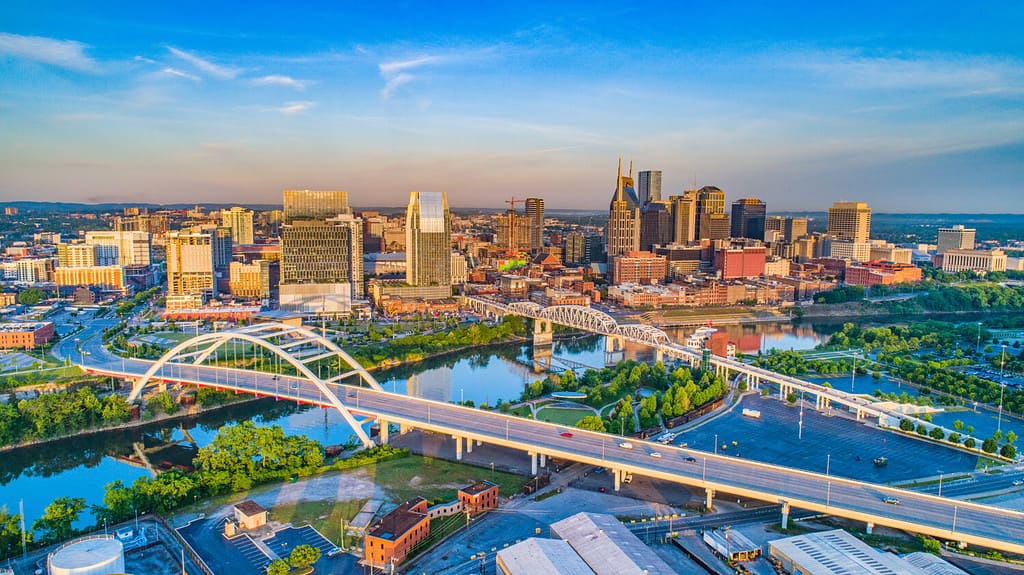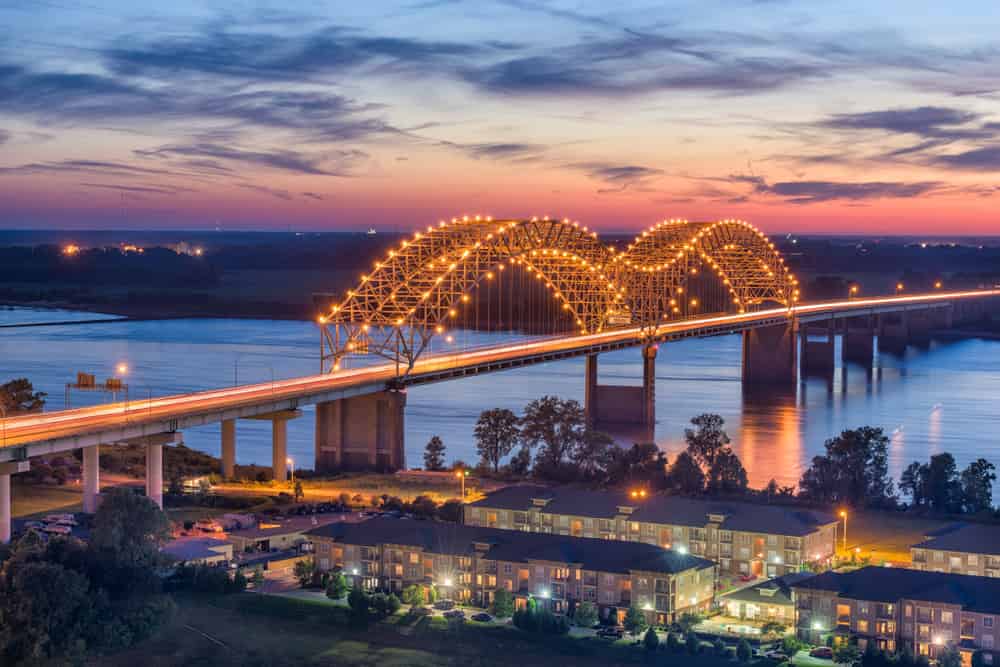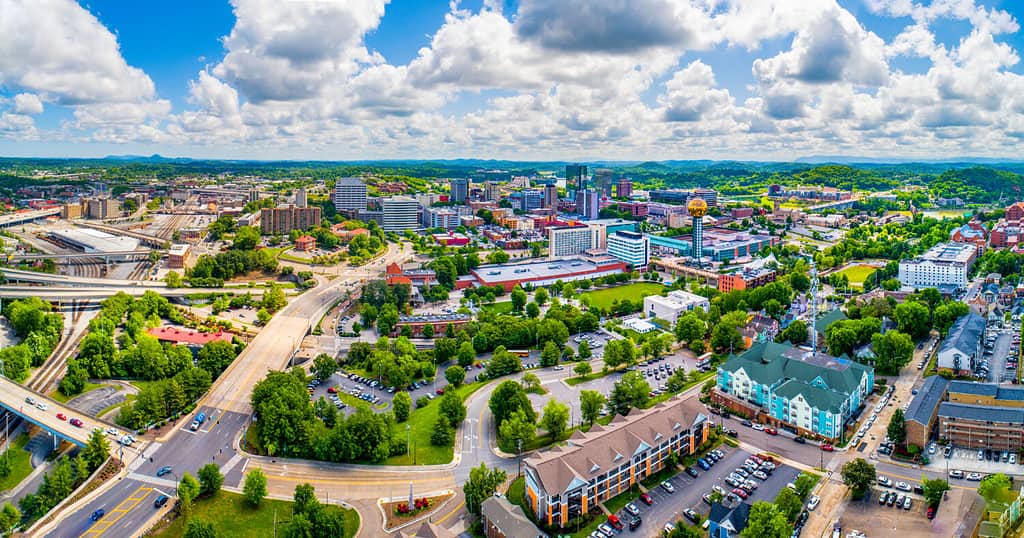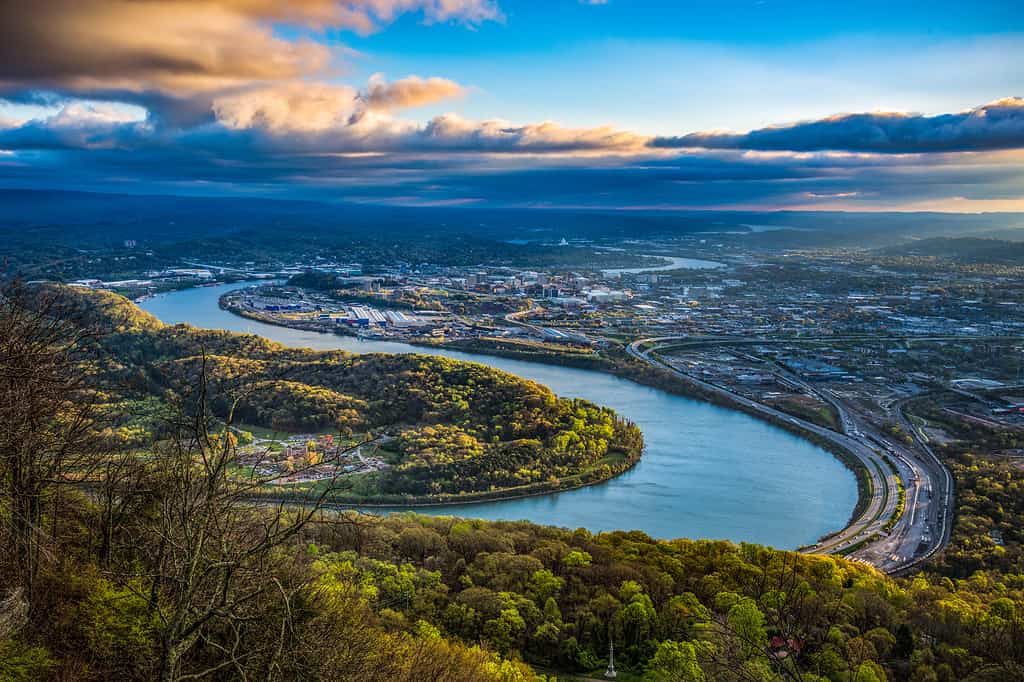Tennessee is a hilly and forested state east of the Appalachian Mountains. It is also the 36th largest state in the United States. Though it is not one of the largest states in the U.S., it does have a population in the top 20, a vibrant cultural scene, and a diverse and thriving economy. Much of this vibrancy is found in its cities. So, what are the three largest cities in Tennessee?
Largest Cities in Tennessee by Population
Let’s begin by looking at the largest cities in the state by population. The figures in the table below are based on statistics from the 2020 U.S. Census. Population density calculations are based on these figures in conjunction with the recorded land area of each city.
| City | Population Density | Population |
|---|---|---|
| Nashville | 1,367.9/sq mi | 689,447 |
| Memphis | 2,146.7/sq mi | 633,104 |
| Knoxville | 1,931.8/sq mi | 190,740 |
Nashville
Nashville is Tennessee’s capital city, so, unsurprisingly, it leads the state in total population, with 689,447 people. It’s also fourth in the southeastern U.S. by population. The Nashville metropolitan area, which includes Nashville, Davidson, Murfreesboro, and Franklin, has a total population of over 2 million people, making it the 35th largest metro area in the U.S. Over the last year, the Nashville metropolitan area has experienced a population influx of nearly 100 people per day. This makes it the 10th fastest-growing metropolitan area in the nation among areas with populations of at least 1 million.

Nashville leads Tennessee in population, area, and economic impact.
©Kevin Ruck/Shutterstock.com
Memphis
A historic city on the Mississippi River, Memphis was named after an ancient city in Egypt. Its population of 633,104 makes it the second most populous city in Tennessee and the fifth in the Southeast. It is the third largest metropolitan area on the Mississippi, behind only St. Louis, MO, and Minneapolis-St. Paul, MN. While the metropolitan area of Memphis is experiencing modest growth, the city is slowly losing population. The population in 2020 dropped 2.1% from the levels recorded in the 2010 census.

Hernando de Soto Bridge at dusk in Memphis, the second-most-populous city in Tennessee.
©Sean Pavone/Shutterstock.com
Knoxville
Initially dealing with issues of geographic isolation, Knoxville experienced its first population boom after the arrival of the railroads. It is one of Appalachia’s largest cities and a cultivator of Appalachian culture. Knoxville has a population of 190,740, while the local metropolitan area has 879,773 people. The city has grown by about 10,000 people between the 2010 and 2020 censuses, and the metro area has experienced more substantial growth, though still below 2.5%.

Knoxville ranks third in Tennessee by population.
©Kevin Ruck/Shutterstock.com
Largest Cities in Tennessee by Total Area
Population density in Tennessee varies according to city size. This results in surprising differences because smaller cities may have a higher population density. Note that the numbers below differ from those used in the population density calculations. The comprehensive area of a city includes water, which wasn’t used for population density calculations. The area measurements used for population density were land areas.
| City | Area |
|---|---|
| Nashville | 525.94 sq mi |
| Memphis | 302.55 sq mi |
| Chatanooga | 150.08 sq mi |
Nashville
Nashville has the largest land area by far of any Tennessee city. It’s more than 60% larger than the next largest city. The city is located on the Cumberland River and is surrounded by hills. The Cumberland River sits about 385 feet above sea level, while the Radnor Lake State Natural Area, its highest point, sits 1,163 feet above sea level. The city experiences hot summers, while the winters are pretty mild. There is plenty of rainfall in Nashville, as well. Sinkholes are also a common problem within the porous bedrock found within the city.
Memphis
Tennessee’s second-largest city by area is Memphis, on the Mississippi River. Like much of Tennessee, Memphis experiences hot summers, mildly chilly winters, and a lot of rainfall. There are four aquifers within Shelby County, Memphis’ home county. The area held by Memphis has been shrinking as the city is returning some of its land to Shelby County.
Chattanooga
Chatanooga is Tennessee’s third-largest city by area at just over 150 square miles. It sits by the Tennessee River, between the Valley and Ridge portion of the Appalachian Mountains and the eastern edge of the Cumberland Plateau. Like other cities in Tennessee, Chattanooga has four seasons, with hot summers and mild winters. Those hot summers are getting hotter due to climate change, and Chattanooga is tied for the fifth-fastest warming city in the United States.

Chattanooga rests on the Tennessee River, between the Appalachian Mountains and the eastern edge of the Cumberland Plateau.
©Kevin Ruck/Shutterstock.com
Tennessee Cities With the Largest Economic Impact
Tennessee has a surprisingly robust and diverse economy, leveraging agriculture, technology, manufacturing, tourism, and healthcare. This diversity is spread among its largest cities. In 2022, Tennessee ranked 16th in state annual GDP, with 475 billion dollars.
| City | GDP in Thousands of Dollars |
|---|---|
| Nashville | 132,202,284 |
| Memphis | 76,749,486 |
| Knoxville | 43,307,309 |
Nashville
Healthcare is the number one industry in Nashville, bringing over $30 billion annually to the local economy. It is also well-known for its music and recording industries. The automotive industry is also starting to impact local employment significantly. The city hosts high-profile employers such as Bridgestone, Dell, Dollar General, Tractor Supply Company, the Hospital Corporation of America, and others. Nashville is trending well among large metropolitan areas with a GDP of over $132 billion and the most economic growth in 2021.
Memphis
Memphis has used its location on the Mississippi River to its advantage to the tune of $76 billion in GDP. It also has access to an intersection of railroads, interstate highways, and the Memphis International Airport — the busiest airport for cargo in the world. This makes the city a key cog in logistics, transportation, and shipping. It makes sense, then, that Memphis would be an ideal location for the headquarters of such companies as FedEx and Autozone. It also hosts other companies such as International Paper, Cargill Cotton, and Varsity Brands. Memphis’ economy outpaced the U.S. for only the second time in the past decade in 2021.

Memphis, TN, has an area of 324 square miles.
©iStock.com/Kruck20
Knoxville
With a GDP of over $43 billion, Knoxville has the third-largest economy in Tennessee. Knoxville had a thriving textile industry in the first half of the twentieth century. After the industry’s collapse in the 1950s, the city diversified its economy. Now, jobs within the region are found in government, professional services, manufacturing, education, healthcare, hospitality, and retail. The headquarters for the Tennessee Valley Authority is located here, as is the base for the large truck stop company, Pilot Flying J. The Knoxville economy is expected to show slow but stable growth shortly.
Conclusion
Tennessee has much to see and do, with beautiful natural resources, significant cultural sites and activities, and plenty of job opportunities in various industries. Nashville is the leader in population, area, and GDP, with Memphis taking up a solid second-place finish. Knoxville follows in population and GDP, while Chattanooga is the third-largest city in the state in terms of area.
The photo featured at the top of this post is © Kaldari / public domain. – License / Original
Thank you for reading! Have some feedback for us? Contact the AZ Animals editorial team.







